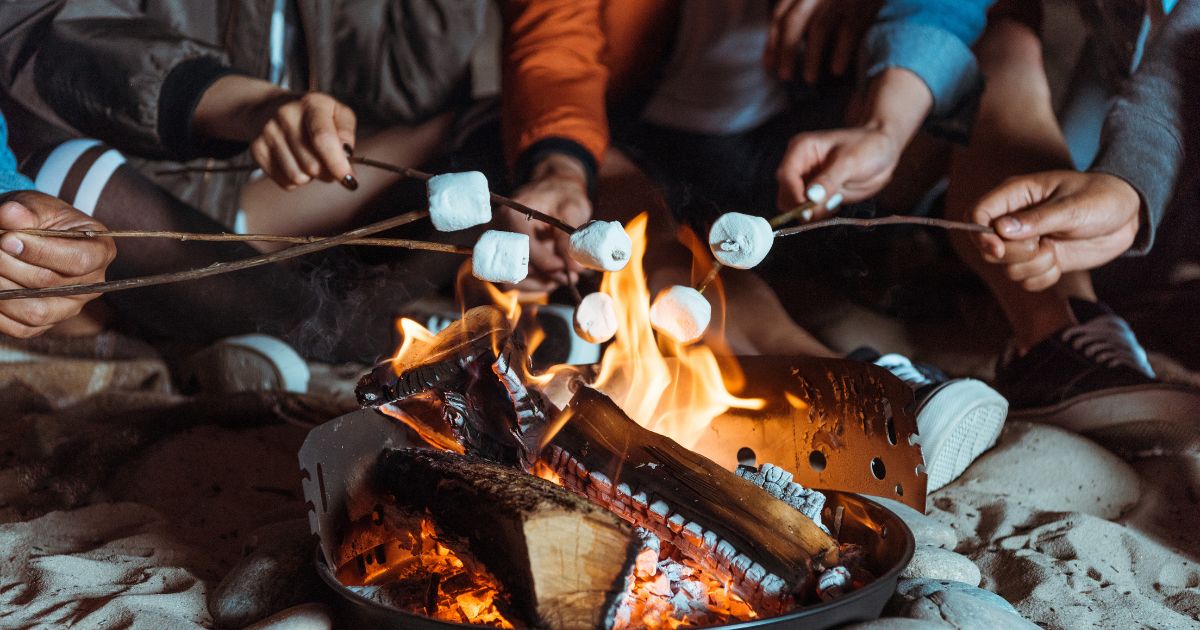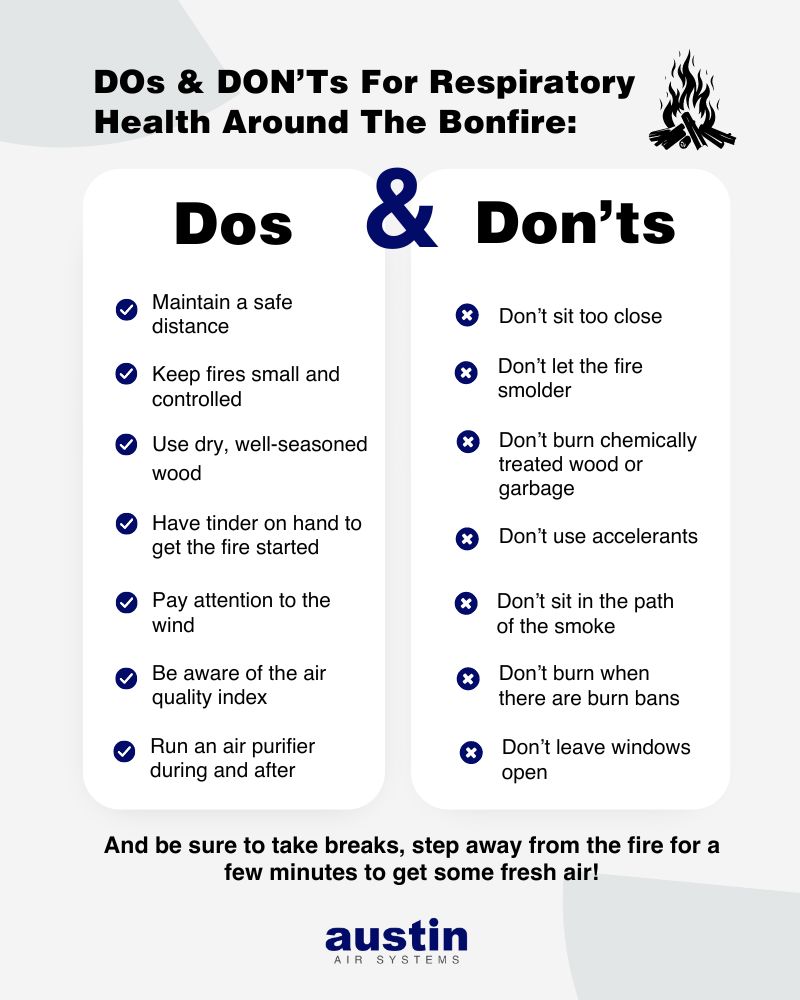As we approach Memorial Day, the unofficial kickoff to summer 2024, many of us are eagerly anticipating outdoor gatherings, BBQs, and, of course, cozy bonfires under the starry night sky. While bonfires are a beloved summer tradition, they also pose potential risks to respiratory health. Whether you’re celebrating with family and friends or simply enjoying a quiet evening by the fire, it’s crucial to be mindful of how bonfire smoke can impact your lungs. Here’s how you can enjoy your bonfires safely while protecting your respiratory health.
Understanding the Risks of Bonfire Smoke
Bonfire smoke contains a mix of gases and fine particles from burning wood and other organic materials. These particles can irritate the respiratory system and exacerbate conditions like asthma, heart failure, chronic obstructive pulmonary disease (COPD), interstitial lung disease, and irregular heartbeats. Even for those without pre-existing conditions, prolonged exposure to smoke can lead to respiratory issues and decreased lung function.1
Tips for Protecting Your Lungs
General fire safety is crucial (of course) but it’s important to consider your respiratory health too.
Maintain a Safe Distance
Position yourself upwind of the bonfire to minimize smoke inhalation. Staying at least a few feet away from the fire can reduce your exposure to harmful particles. Heat is also a concern, as hot air can cause damage in the respiratory tract. If your face or hands feel hot, you’re too close.2
Keep Fires Small and Controlled
Larger fires produce more smoke. Keep your bonfire small and manageable to limit the amount of smoke generated.
Use Dry, Well-Seasoned Wood
Wet or green wood creates more smoke and releases more pollutants. Always use dry, seasoned wood for your bonfires to ensure a cleaner burn. If you’re a bonfire enthusiast, consider investing in a wood moisture meter. (20% moisture or less burns best.)3
Avoid Burning Toxic Materials
Never burn chemically treated wood (including pressed wood, construction materials, stained wood), plastics, or other synthetic materials. These can release toxic chemicals that are harmful to your lungs and the environment.
Skip the Accelerants
It can be frustrating when a fire won’t start but resist the temptation to use accelerants to start the fire, like lighter fluid or gasoline. 1. They can be very dangerous, causing the fire to spread outside the designated burn pit. 2. When they are burned, they release harmful gases.
Take Breaks
Step away from the fire periodically to give your lungs a break from the smoke. This is especially important for children (whose lungs are still growing), the elderly, and anyone with pre-existing respiratory conditions.
Don’t Let the Fire Smolder
“Smoldering” is when a fire is burning slowly, without a flame. Before starting the fire, have items on hand to help get the fire going like dried leaves and small sticks. These can be smoky to start so if you have a respiratory condition, wait until the fire is fully burning before heading to the fire pit.4
Pay Attention to the Wind
Seat yourself out of the path of the smoke by paying attention to the breeze. Be mindful about wind speeds too, avoid having a fire entirely if the wind is 20 miles per hour or more.
Be Aware of Air Quality
Check the local air quality index (AQI) before planning your bonfire. On days with poor air quality, it’s best to postpone your outdoor fire activities – like when a wildfire is burning, such as the Canadian wildfires last year which caused bad air quality throughout large portions of the US and Canada.
Consider Natural Gas or Propane
Gas burning fireplaces don’t grow on trees but if one of your friends or family has a natural gas or propane outdoor fireplace, it might be best for them to host the bonfire portion of your summer gathering.
Close All Windows and Doors
Prevent the smoke from entering your home by closing all the windows and doors, especially those that are directly facing the fire pit.
Run An Austin Air Purifier on High
Some smoke will inevitably find its way into your home – which you’ll know because of the infamous “bonfire smell” that you will likely smell the following day – so make sure to run your Austin Air air cleaner(s) on high during and after the bonfire.
For Those with Respiratory Conditions
If you have asthma, COPD, or any other respiratory condition, it’s important to take extra precautions:
- Always have your inhaler or medication handy.
- Limit your time near the fire.
- Stay alert to any signs of respiratory distress.
Enjoying Summer Safely
Memorial Day marks the beginning of many joyous summer activities, and bonfires are a wonderful way to celebrate. By taking these simple precautions, you can enjoy the warmth and ambiance of a bonfire without compromising your respiratory health. Here’s to a safe, healthy, and happy summer 2024!
Remember, your lungs are vital to your overall well-being. Protect them by staying informed and taking proactive steps to reduce your exposure to harmful smoke.
If you’re a major fan of bonfires (who isn’t?), consider adding an Austin Air HealthMate Plus to your home. The HealthMate Plus contains potassium iodide-impregnated activated carbon which has the ability to remove contaminants found in bonfire smoke, such as formaldehyde.
And always remember the basics of fire safety – don’t have a bonfire if there is a burn warning in effect, you wouldn’t want to start a wildfire.
Happy Memorial Day and happy summer!
REFERENCES
1 How to Minimize Unanticipated Lung Problems Caused by Campfires. (2023 July 1). Campbell County Health. https://www.cchwyo.org/news/2023/july/how-to-minimize-unanticipated-lung-problems-caus/.
2 Fire Pits, Bonfires and Your Lungs: Safety Tips to Follow. (2024, April 30). Cleveland Clinic. https://health.clevelandclinic.org/fire-pits-bonfires-and-your-lungs-7-safety-tips.
3 Wood Smoke and Your Health. (2024 April 9). US Environmental Protection Agency. https://www.epa.gov/burnwise/wood-smoke-and-your-health.
4 Learn Before You Burn. (2022 November 21). American Lung Association. https://www.lung.org/local-content/mn/learn-before-burn.


